 News
News5 February, 2025
Weeks to Launch: 4
Welcome back to another issue of the AOPA-Retrospective Launch 1.0 newsletter! We’re officially a month into 2025, and we here at AOPA are hard at work in anticipation of the platform’s reveal.
Last time, I introduced you to the Exhibition Single page where an artist’s works can be viewed by their exhibitions. But what about the other ways their oeuvre can be categorized?
Can artworks be grouped by those elements as well?
The answer is “yes” and is found in the Taxonomy Main and Taxonomy Single pages! Allow me to explain.
Enjoying our newsletters? Share the news! New readers can sign up here!

Screen Capture showing the Taxonomy Themes Main Page of artist Karen Trask’s retrospective.

Screen Capture of Karen Trask’s Taxonomy Single Page for the theme Undoing the Printed Word.
It’s not as obscure as it seems! Taxonomy is just computer-world jargon. Don and Valeriu use it all the time. Alex, APOA’s designer, even started to use it. And I’m getting used to it too!
It is a word in data science that was borrowed from biology for classifying things based on shared characteristics. For AOPA, it’s pretty simple.
AOPA-Retrospective 1.0 has three built-in Taxonomies:
If you have others, they can be created.
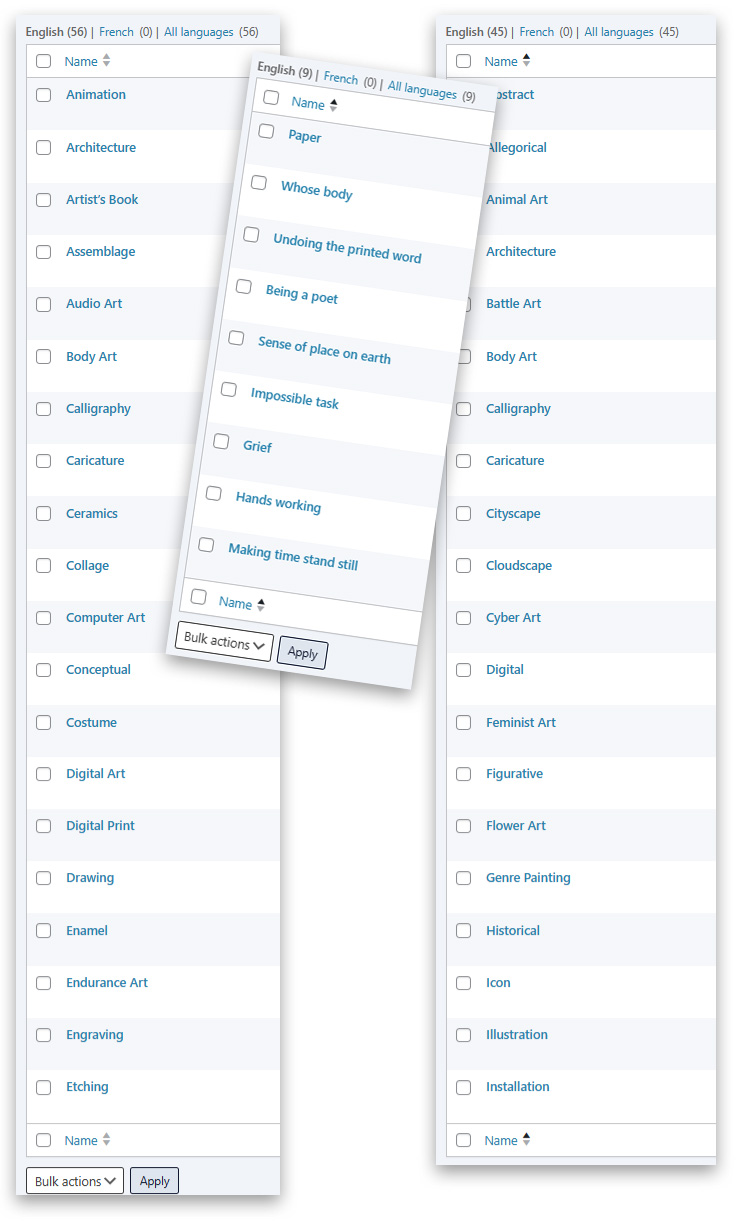
Graphic showing WordPress Admin interface showing list of Artforms, Themes (Karen Trask) and Genres.
All taxonomies have taxonomy items. Here is a sampling of the Taxonomy Items from the first two taxonomies (you can also see them in the screen capture above); they’re built into AOPA-Retrospective.
As for Artwork Themes, those are unique to each artist. The Dedicated Curator can collaborate with the artist to help distill out what these could be.
AOPA-Retrospective takes its name from our belief that an artist’s oeuvre can be digitally organized as if it was being shown in a physical retrospective exhibition.
There are two types of pages in AOPA-Retrospective 1.0 that provide this organisation:
To elaborate on the exhibition comparison… The Taxonomy Main page acts like an exhibition map showing the different thematic galleries. This “map” allows visitors to orient themselves and choose the path they would like to take through the retrospective.
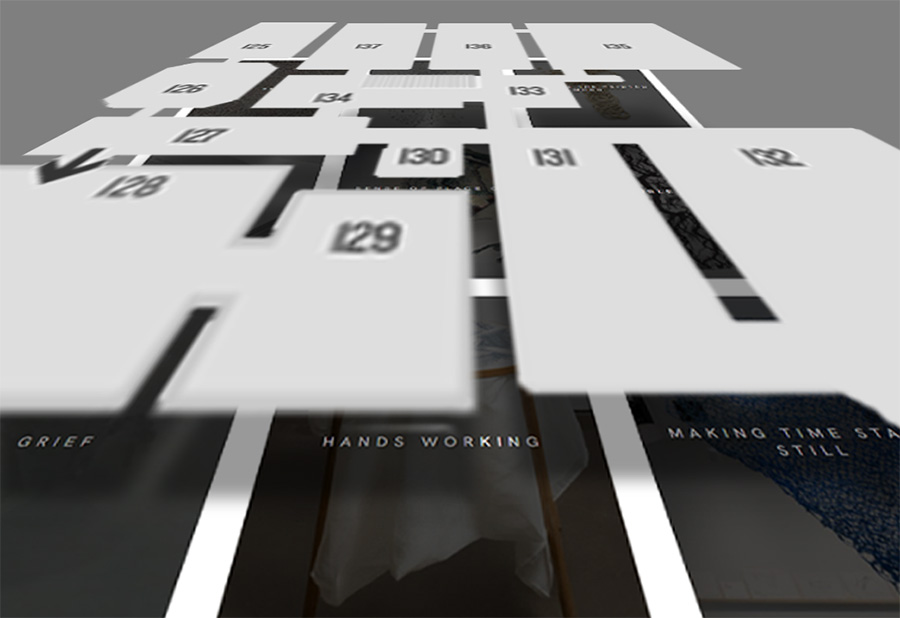
Graphic showing a museum floorplan overlaid on the Taxonomy Main Page from Karen Trask’s website.
Each of the the Taxonomy Item pages correspond to the gallery rooms in the exhibition, showing the artworks that are classified in that grouping.

Graphic showing overlay of artwork tiles from Karen Trask’s Grief Theme Taxonomy Item page.
Each gallery on the Taxonomy Item Pages is a dedicated space that invites consideration and appreciation of some aspect of an artist’s oeuvre. It’s where visitors/users, and even the artist can trace connections between artworks, sometimes in unforeseen ways!
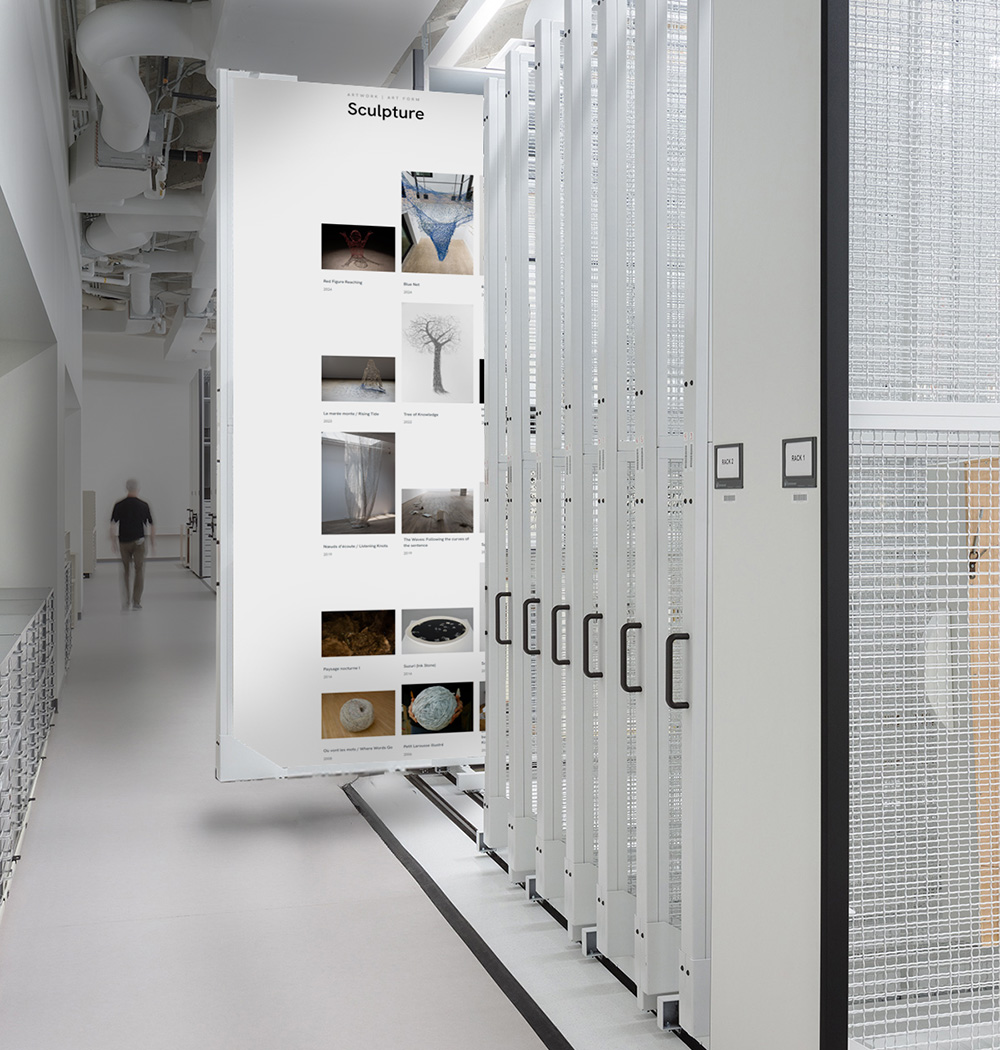
Graphic collage showing Karen Trask’s Taxonomy Single Sculpture page collaged into the storage racks of a museum. exhibition page
In a physical exhibition the artworks can only be grouped in one way; a painting can’t be in two galleries at once. The online retrospective does not have this limitation. The same works presented by Themes can also be grouped in galleries by Art Forms and Genres.
Let’s go back to thinking about curators, critics, art historians and collectors, or “CCACs” for this. By displaying artworks by Art Form or Genre, CCACs can browse an artist’s oeuvre based on their particular needs.
For example, a curator who is preparing an exhibition dedicated to craft materials can navigate to an artist’s Ceramic, Textile Art and Weaving Taxonomy Item pages to see all the artist’s works using those mediums. Similarly, an art historian pursuing in-depth research on Feminist Art or Landscape can go to those Genre Taxonomy Item pages. Or say there’s a collector seeking the perfect piece to complete their collection of watercolours… You get the idea.
Sorting works this way allows CCACs to easily focus in on an artist’s exploration of a given Art Form, Genre or Theme, and even see their evolution over time, because the artworks are ordered chronologically.
So, you see why Taxonomies are such a big deal? Okay! Now let’s see how these pages navigate.
Let’s imagine that you’re browsing an artist’s Artwork Themes Taxonomy Single page and a theme called Nature and the City piques your interest. By clicking on that theme, you enter the Nature and the City Taxonomy Item Single page. This page shows all of the artist’s works that are tagged with “Nature and the City”.
Once there, all of the artworks in Nature and the City are displayed as thumbnail images. When hovering over an artwork’s thumbnail, you can open a continuous, full-screen slideshow that lets you browse through all the images and video documentation for that piece and all the other Nature and the City artworks. Hovering over an artwork’s thumbnail also gives you the option of clicking through to its Artwork Single page for a more in-depth look.
As always, everything comes back to the art!
Check out this video tour that navigates through the Taxonomy pages, the a Taxonomy Item slideshow and link to the artowork page.
Video showing navigation of the Taxonomy pages, taxonomy item slideshow and link to artwork page

Graphic illustrating the connections between artwork, its exhibition history, the exhibition and its taxonomy items drawn from the artworks
Let’s go deeper into the interconnected navigation that AOPA-Retrospective creates.
Earlier, the Nature and the City Taxonomy Item page took us to the Artwork Single page. As we saw last week, the Artwork Single page’s Exhibition History lists all of the exhibitions that a work was shown in, allowing us to click through to an exhibition of interest. On the Exhibition Single page, we can see the Themes of the works in that exhibition… which can take us to a different Taxonomy Item that we started with, and so on!
Essentially, all of these connections go both ways to make browsing natural. You can go from an Artwork Theme Taxonomy Single page to an artwork, to an exhibition, all the way to another art form… and back again!
It might not be obvious to you how all Taxonomy-Related pages are actually created. It is quite simple, the AOPA-Retrospective templates do all the heavy lifting.
The Dedicated Curator or artist just has to go to the administrative interface for an Artwork, and select the appropriate Themes, Artforms and Genres for that piece using simple checkboxes.
When these Taxonomy Items are selected, they are automatically added to AOPA-Retrospective’s beautifully designed Taxonomy Main page, with links to the Taxonomy Item pages. Likewise, the Taxonomy Item pages, showing all its artworks in the Taxonomy Item, are magically added to the website, with all the related artworks in place.
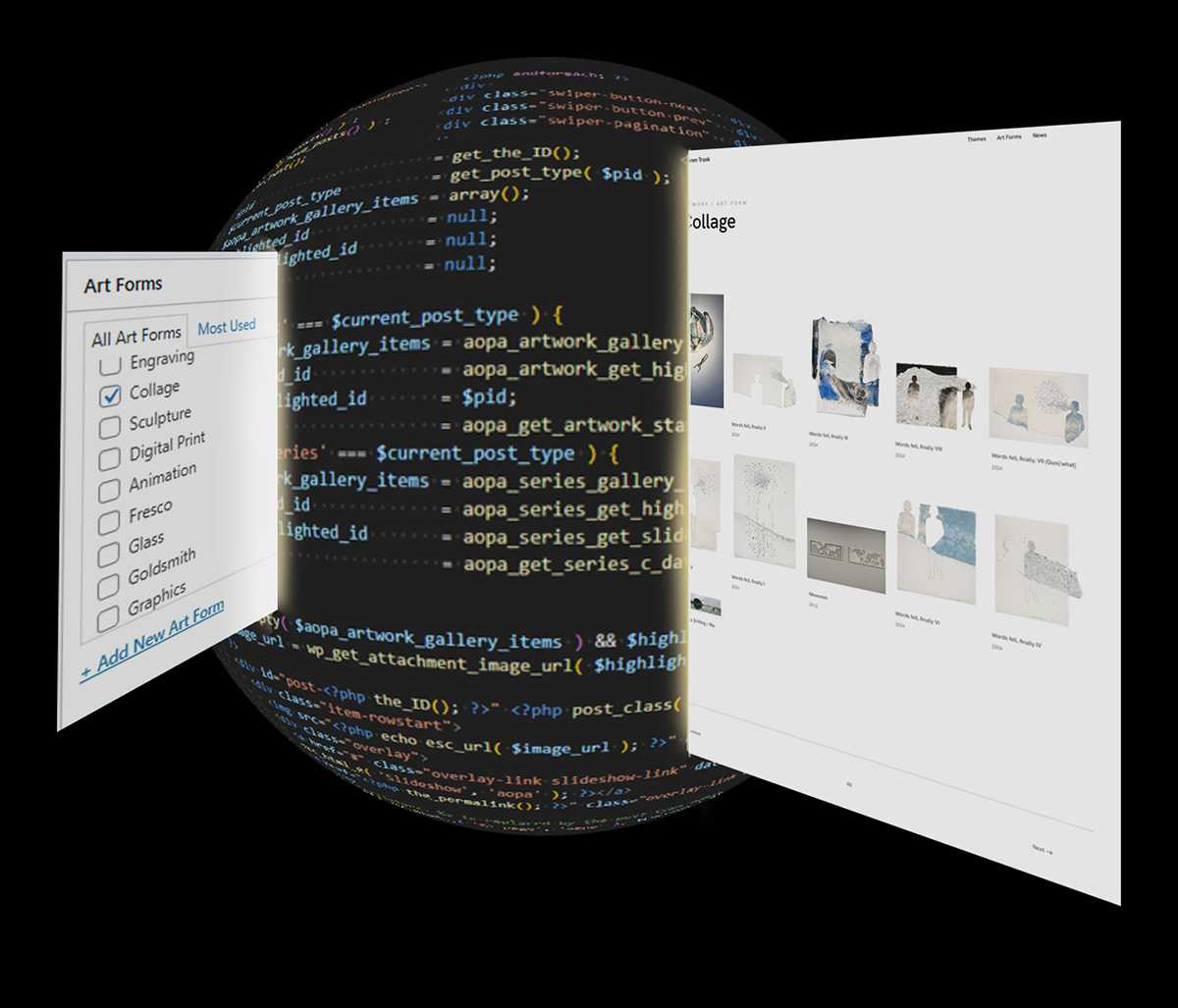
Graphic showing how checking “Collage” in an artwork, goes through Retrospective’s code to create the Collage Taxonomy Item page
In some cases, you may not want to make a big deal of one of the Taxonomies built into your AOPA-Retrospective. For example, if you work exclusively with oil paints or installations, there wouldn’t be a need for an Art Form Taxonomy Main page with only that one item.
In AOPA-Retrospective 1.0’s Preferences, you can decide whether or not you want the Art Form, Genre or Theme pages to be published. If not, all links and navigation to these are removed. The Taxonomy Items are still listed in Artwork and Exhibition metadata, they are just not clickable.
Plus, this can always be changed later to suit your needs. With a click of a button, your Taxonomy pages are there. Easy-peasy!
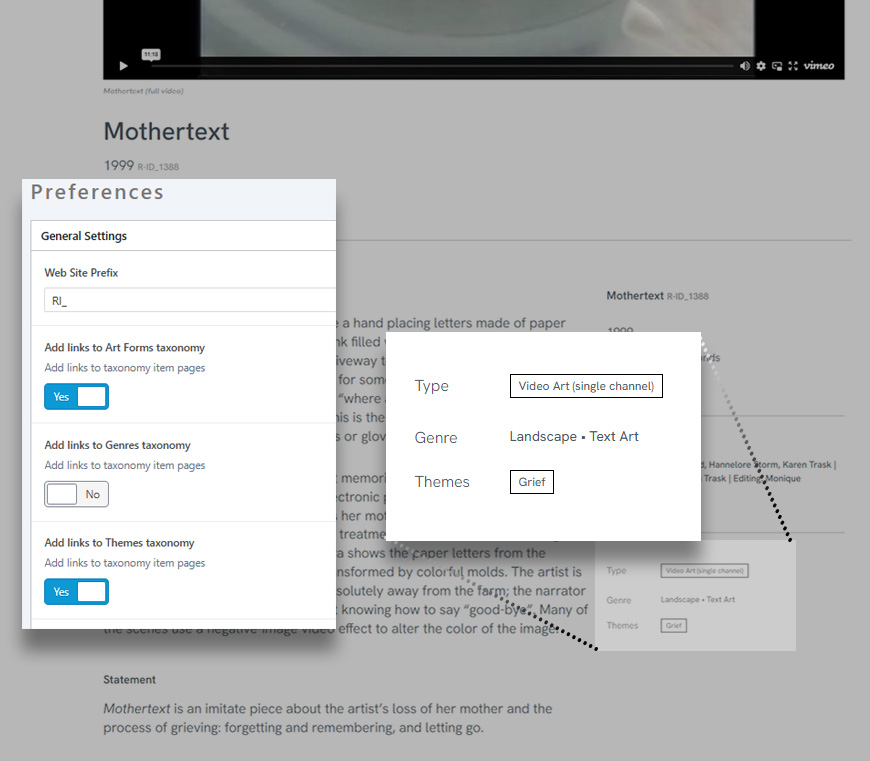
Graphic showing a screen capture of Retrospective’s Preferences and the Taxonomy metadata from an artwork showing linked and not linked Taxonomy Items.
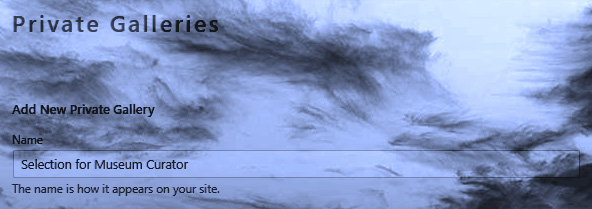
Graphic showing the Private Gallery Taxonomy admin interface still in the clouds.
As we wrap up, I want to let you in on a rumour I heard from Don. Word on the street is that he’s thinking of adding a Private Gallery Taxonomy to AOPA-Retrospective.
He said that Taxonomy Items could be things like “Selection for Museum Curator” or “Works I want to show that buyer I met at the opening”. This would allow artists to make a private gallery with the works they would like to show to a specific curator, critic, art historian or collector. Then, a link to the page could be sent out for the recipient to review — like a personal gallery visit!
So… What do you think? Is this a good idea?
I can’t tell you the number of times I have wanted to do a deep dive into an artist’s works on a particular theme or in a select medium, only to have to browse one long list of artworks and manually pluck out the ones that were relevant to me. As we’ve seen, AOPA-Retrospective 1.0 makes browsing an artist’s oeuvre easy by making ample connections between works, inviting all kinds of art appreciation.
Thanks for spending another week with us! It’s always a pleasure to share these updates. Every week, I hope you can picture the AOPA-Retrospective 1.0 platform a little more clearly… and get a lot more excited for the launch!
Feel free to get in touch with any questions or feedback. You can shoot us a message over at our contact page. We love hearing from you!
Can’t wait for the AOPA-Retrospective launch? Want to shout it from the rooftops? Share the newsletter signup page! It’s the best way to get friends and colleagues up to date with all of the platform’s newest developments.
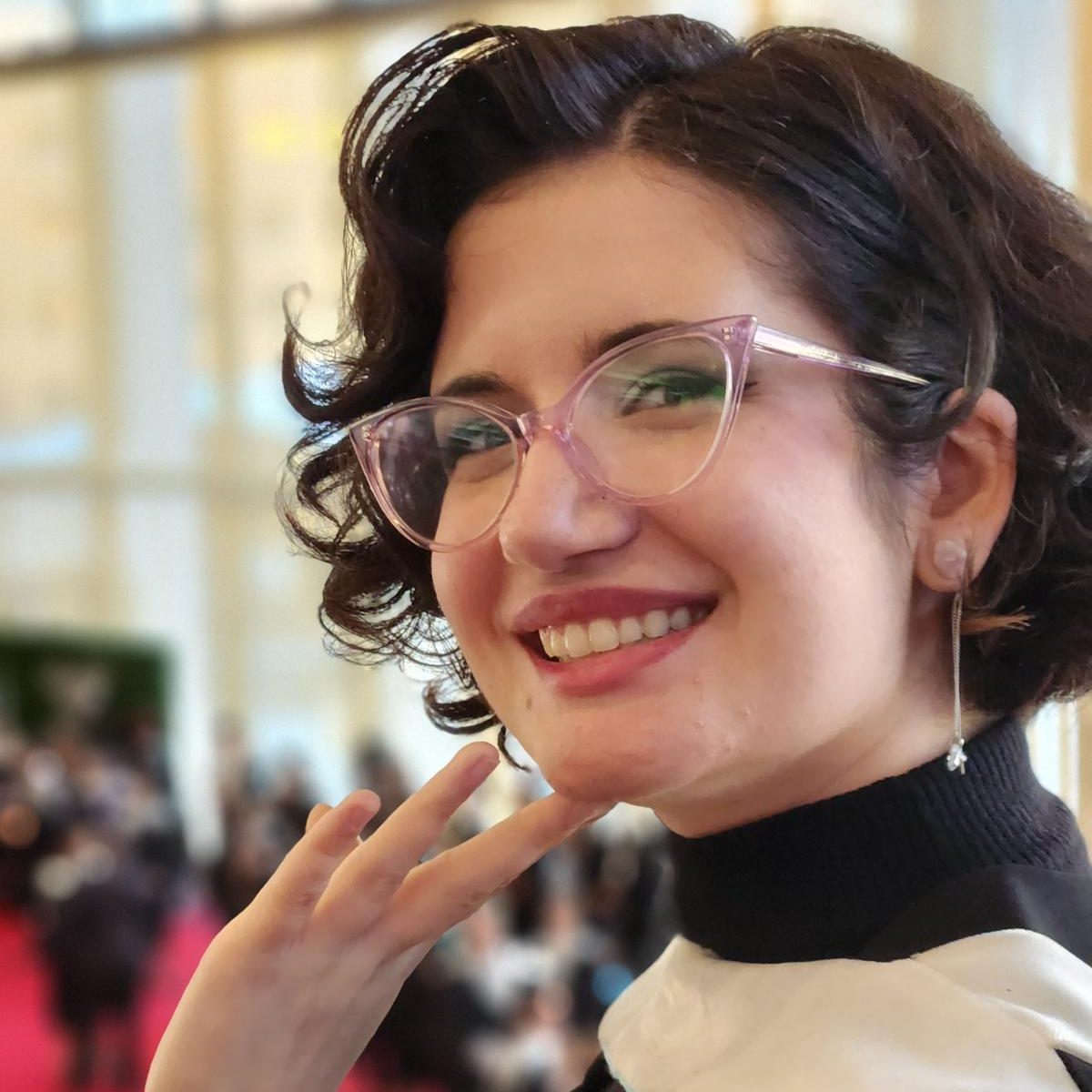
Mya Fernandes-Giles, AOPA Dedicated-Curator Assistant
Master’s student in Art History at Concordia University, working on a project that relies heavily on alternative archives. Has a great appreciation for record-keeping and cultural preservation, especially amongst little-known artists and communities. Recipient of the Concordia Merit Scholarship, the Guido Molinari Prize in Studio Arts and the Sarah Leaney Award in Ceramics and Fibers.
Artist Online Presence and Archiving (AOPA), provides professional online archiving and web-development services to mid- to late-career contemporary visual artists. AOPA was founded in 2023. It grew out of the freelance work of Don Goodes, who was an art critic and curator in Canada for a decade before moving over to web development in the cultural sector. AOPA delivers its services via a growing team of freelance writers, curators and designers spread across Canada. Over the past 2 years, the core team has been developing a flexible and comprehensive online platform called AOPA-Retrospective, a key tool in delivering AOPA’s services. AOPA-Retrospective is designed to fulfill the needs of contemporary artists, for both archiving and the online presentation of their oeuvre in the spirit of the catalog-raisonné.
For questions or inquiries see our contact page. We would love to hear from you.
23 January, 2025
Video tour of Exhibition Single. Watch on Youtube
Weeks to Launch: 1 + 4
Belated happy New Year from all of us here at AOPA, and a warm welcome back to the AOPA-Retrospective 1.0 Launch newsletter!
We want to start by acknowledging that we slacked off with our newsletters. Things remain tremendously busy behind the scenes. Between holidays and the drive to keep production of AOPA-Retrospective 1.0 moving forward, these updates got put on the backburner. Let’s get you caught up, shall we?
Our team has continued to make progress on the AOPA-Retrospective platform, but it is always more work than expected. As such, the launch will be moving ahead by one month — with additional updates from me to keep you company during the wait!
This week, we will be looking at the Exhibition Single Page and what delicious features it brings to the table for both artists and that important group of curators, critics, art historians and collectors.
I want to give a big thanks, once again, to Karen Trask for giving us permission to use screen captures from her website in development with AOPA. Enjoy her amazing work.
Like our newsletters? Share the news! New readers can sign up here!

Screen capture of the exhibition page for Karen Trask’s Ombre et la forme exhibition.
You may have noticed that our first three newsletters were all about artworks. This was no coincidence: artworks are AOPA’s raison d’être. Today, we’re looking at the next most important thing: exhibitions… those times when your artworks have traveled out of studio into the public eye.
For artists, it’s a time of mixed emotions. There is a satisfaction in seeing the works grouped together, in seeing your body of work as a whole. When artworks are exhibited, they’re out in the world to be seen, experienced, and yes, even critiqued.
These moments gives legitimacy and special status to the artworks exhibited, serving as a form of validation for both artists and their works.
Many artists have scattered archives related to their exhibitions. AOPA-Retrospective’s Exhibition Single template provides a tidy container to organize all of this information in digital form.
Exhibition Single pages tell key users, especially CCACs (curators, critics, art historians and collectors) about these important moments. They are meant to answer their questions and satisfy their curiosity by offering as many details and as much documentation as possible.
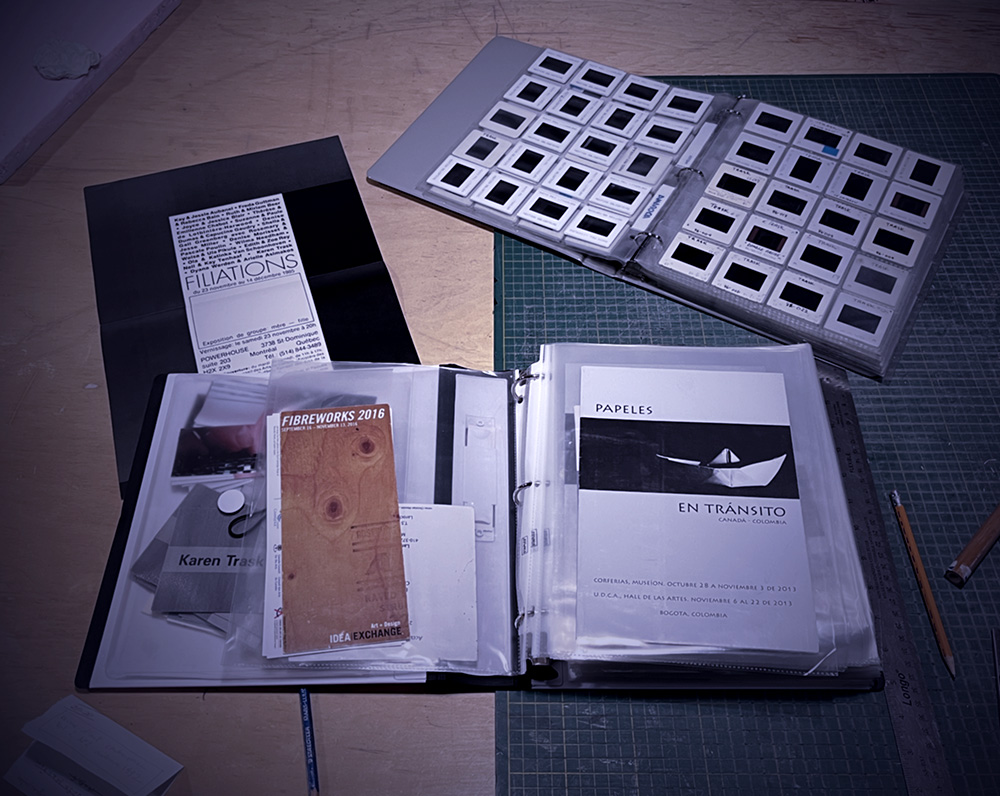
Karen Trask’s exhibition binder and slides
Let’s start our tour of the Exhibition Single Page with that wealth of information of the type that we call metadata. Check out the labels in the screen capture below from Karen Trask’s exhibition page for … and a room in the bag of stars. They describe some of the basic information that can be entered in this template.

Documenting this data is a huge deal! By inputting it into Exhibition Single, the information is centralized and organized in a reliable and easily retrievable way.
Undertaking this task may appear daunting. Some data may seem lost to time, or hidden somewhere in the artists’ distant memory. This is where AOPA’s Dedicated Curators come in.
The Dedicated Curator collaborates with the artist to tease these details out of old exhibition invitations, articles, catalogs and the hidden corners of the internet to fill in the gaps. This is especially satisfying, as this extra effort can seriously solidify information.
For curators, critics, art historians, and collectors (CCACs) the centralization of this basic metadata makes their work significantly easier and more efficient. Not only does the Exhibition Single Page include all of the information they need to do their work, but it also connects data, allowing one to trace chronology, draw connections between artworks, and follow the artist’s work with collaborators and curators.
Exhibition Single has optional data fields for exhibition descriptions and statements. Descriptions are essentially what it says on the tin: a straightforward description of what one would see in the exhibition. A statement is, of course, more personal, digging into the thoughts behind the grouped works.
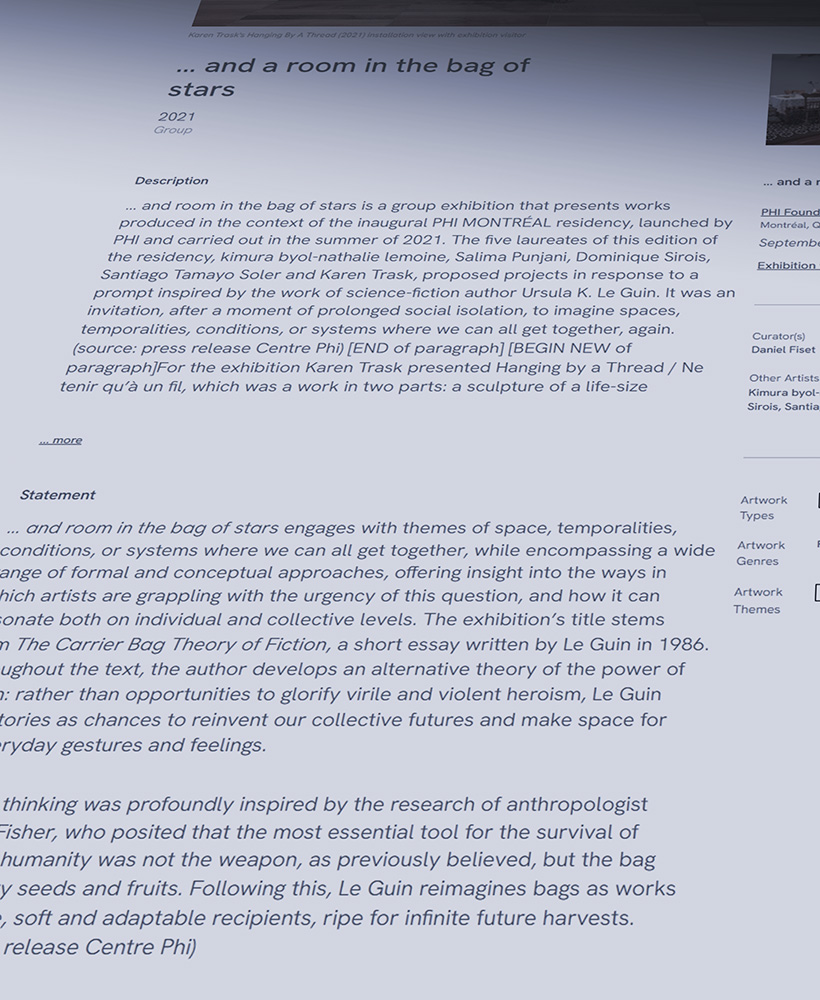
Screen capture of the Descriptions and Statement from Karen Trask’s … and a room in the bag of stars exhibition page
For Artists, the Description and Statement fields:
For CCACs (curators/critics/art historians/collectors):
Next up is the audio-visual documentation of the exhibition. This includes installation photos and walk-through videos, all selected and arranged to best tell the story of the show, establish the location of the works in the gallery, and even give a sense of the space and the atmosphere. All media elements can be viewed in a slideshow.
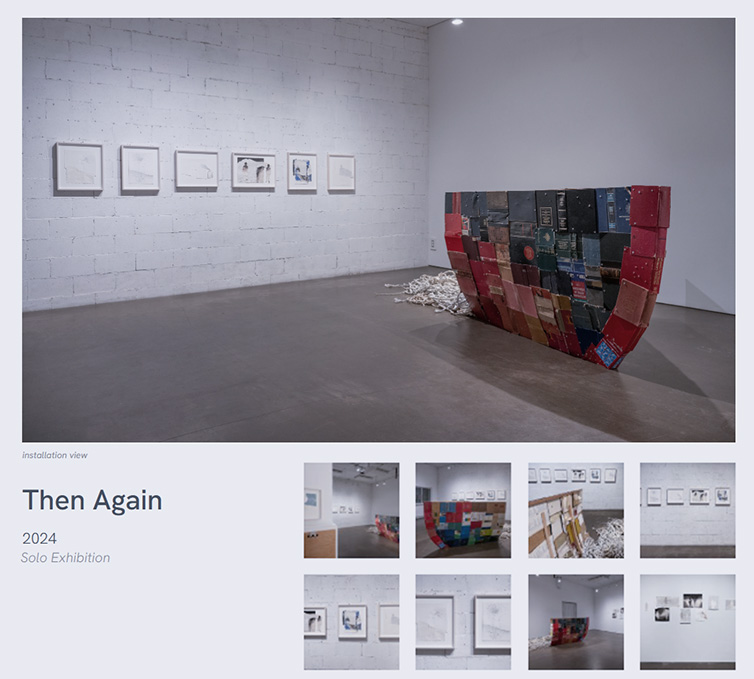
Screen capture of the exhibition views from Karen Trask’s Then Again exhibition page
The Dedicated Curator works with the artist to assemble digital documentation of these elements and begin putting things together. The process often gives the artist the opportunity to step back and realize the scope of their accomplishments, and to take a much-deserved walk down memory lane.
In some cases, translating an exhibition to a digital context will also reveal the documentation that’s missing to properly portray the show. In this case, the Dedicated Curator works closely with the artist to fill in the gaps. For example, digging up old slides to be digitized, researching images from the exhibiting gallery’s archives, finding publications, and even hiring a photographer.
For CCACs (curators/critics/art historians/collectors) it offers:

Screen capture of the slideshow showing an installation view of Karen Trask’s Then Again exhibition
And now the artworks in the exhibition! In the Exhibition Single page, every artwork that was shown can be listed with images and links to their respective Artwork Single pages. That’s right: artworks are directly connected to the exhibitions they were featured in, with more of their story only a click away.
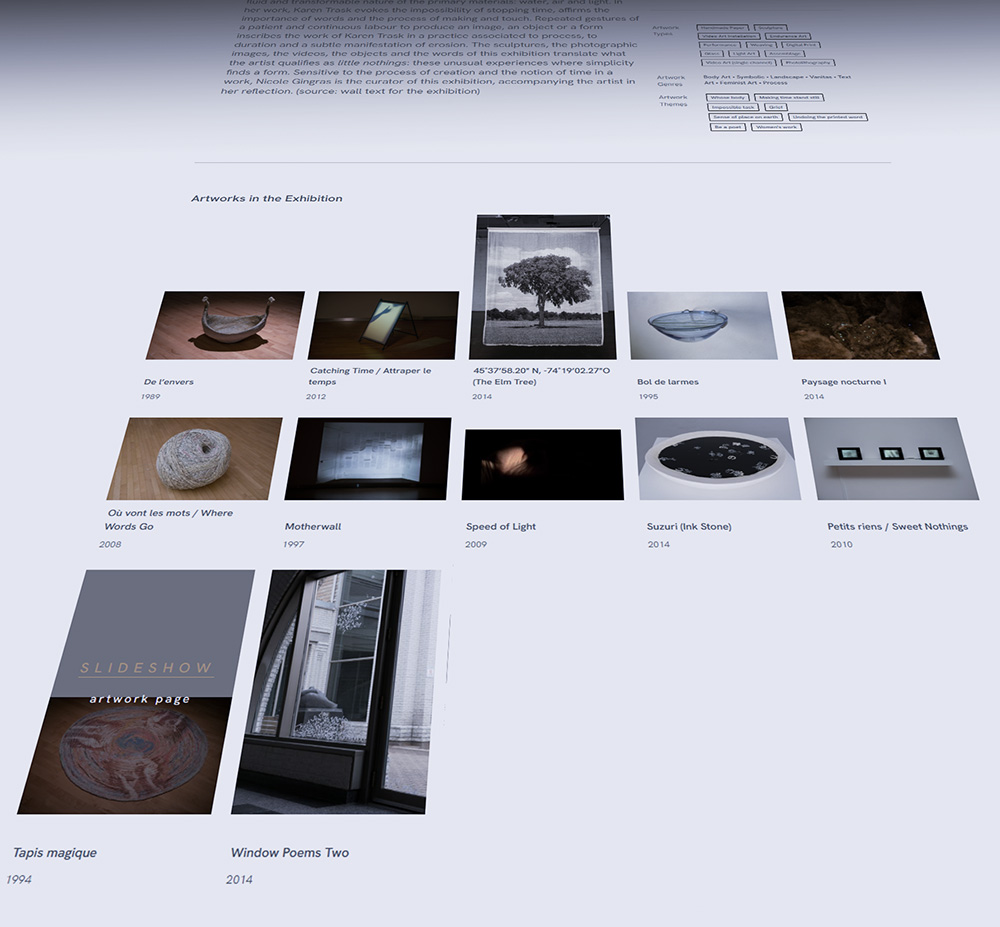
Screen capture of “Artworks in the Exhibition” block for Karen Trask’s L’ombre et la forme exhibition. Note the hover state over the work Tapis magique showing the slideshow and artwork page links.
There is not always a record of which artworks were included in an exhibition. Sometimes a list might have been kept by the artist, but often, we rely on their memory or piece together information from photos. This makes the Exhibition Single Page an opportunity to accurately document and preserve that part of the artist’s history.
For CCACs the Artworks in the Exhibition block offers:
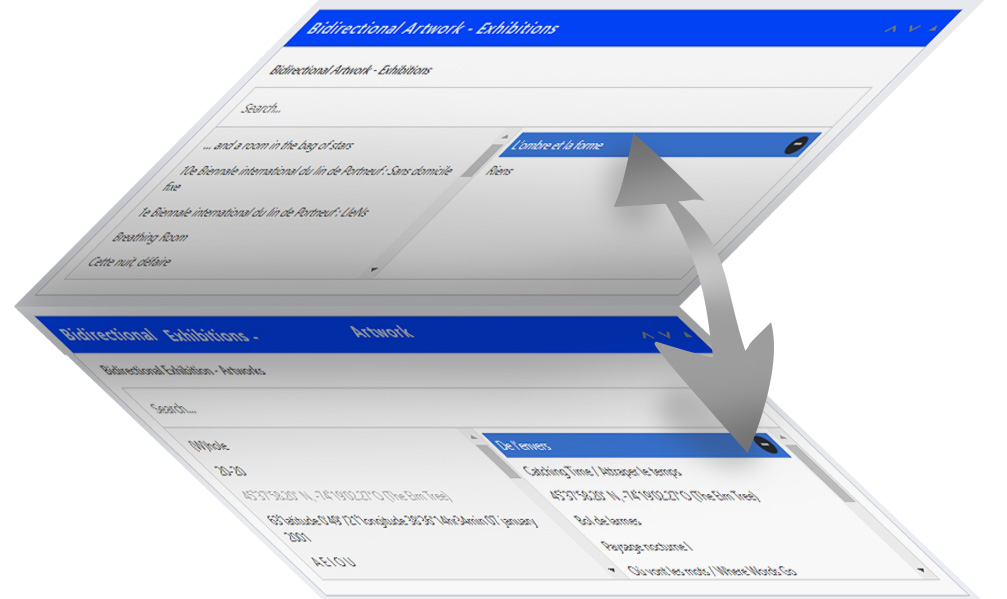
Graphic showing Bi-directional Artwork and Exhibitions interconnected data fields
A special feature of Exhibition Single is that it uses a bi-directional data field to connect artworks to the exhibitions. The same field is found in Artwork Single. The link is made where ever it is most convenient in the workflow. This saves the artist and Dedicated Curator a lot of trouble! With just one click, the exhibition can be added to the artwork’s Exhibition History on the Artwork page or to the Artworks in the Exhibition block on the Exhibition page.
Publications are another standout feature on the Exhibition Single Page. This is where published catalogs, reviews, and articles pertaining to an exhibition or any of the works can be connected and displayed.
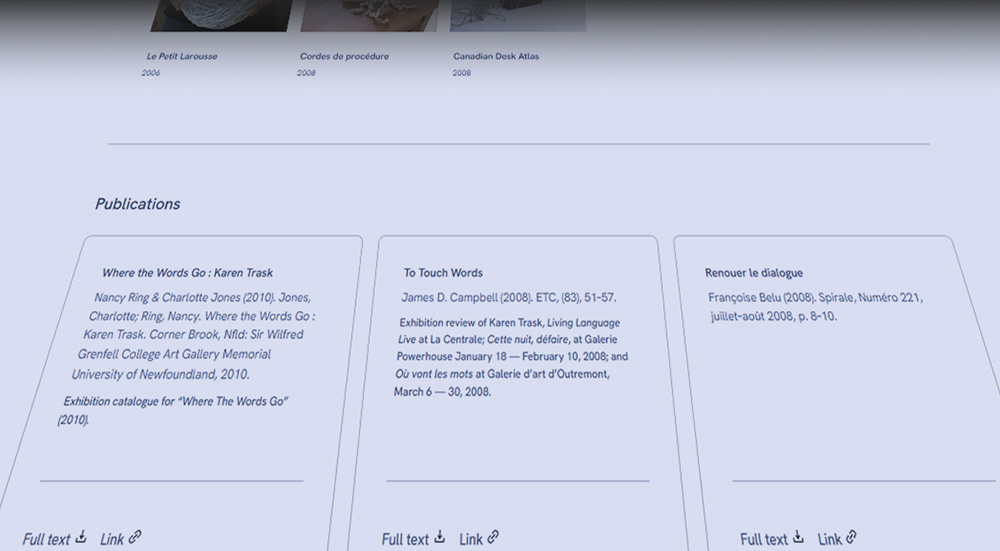
Publications block from Karen Trask’s Où vont les mots exhibition page.
This holds immense value for the artist! These texts can easily slip out of sight. By gathering and centralizing all writing on the exhibition and its works, the artist can get a bird’s eye view of the buzz around their work.
For CCACs, the value of this section is clear. Tragically, it can be exceedingly difficult to track down writings about living artists. Presented all in one place, CCACs can access all collected texts about a given exhibition with full-text files and clear attribution to their respective writers and publications.
And now for my favourite, the Ephemera block. This is an extra special feature of Exhibition Single. It provides a place for any extras, including scans of invitations and other related print materials, photos documenting the installation or the vernissage… Anything the artist wishes to share that is not strict documentation of the exhibition or an official publication can be found here, in the form of documents, media, or text.
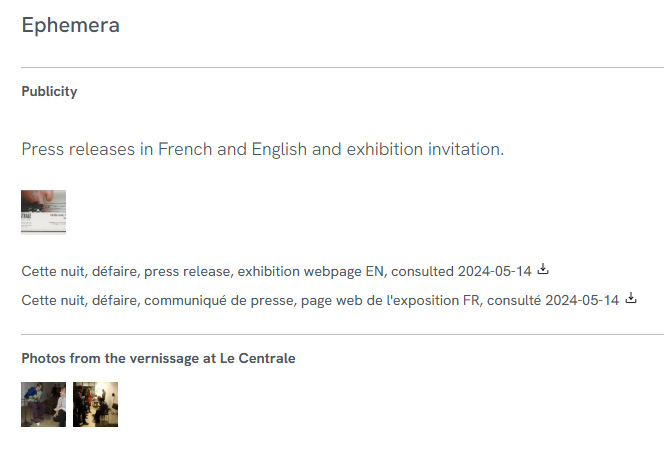
Publications block from Karen Trask’s Cette nuit défaire exhibition page.
For Artists the Ephemera block:
For professional CCACs the Ephemera block:
And to finish off, let me quickly show you two other features of AOPA’s Exhibition Single template.
The first is the “Publish to Retrospective?” radio button that lets you decide which exhibitions you would like to feature on your website’s Major Exhibitions page. If the answer is “no”, the exhibition’s minimum metadata can still be recorded in AOPA-Retrospective for archiving purposes as well as for use in the automatically-generate “Exhibitions” section of the artist’s CV.

Finally, a quiet achiever of AOPA-Retrospective’s Exhibition Single Page is the pagination. On the bottom of every exhibition page, the user can click to the next or previous exhibition. Pagination links let users easily navigate through all the featured exhibitions, rather than having to constantly click back to the main page. This enhances the user experience with an intuitive flow, and best of all, fewer clicks!

Tracing the life of an artwork from its studio to the spotlight is no easy task! The process of creating your exhibitions to bring out the best in the artworks took a lot of time, patience and skill. This is something AOPA aims to accurately reflect in the thoughtful design of its Exhibition Single Page.
A big thank you, as always, for reading — and especially for sticking around after our holiday hiatus! Shoot me a message if you have any feedback. Always good to hear from our cherished reader. Get in touch by clicking here!
Next week, if all goes well, we’ll be back. Given how busy things are, we don’t want to make any promises about the upcoming topic… Whatever the case may be, however, I look forward to keeping you updated on all of our newest developments!
If you’re excited about the return of our newsletters, consider sharing with a friend. Sign up for this newsletter here.

Mya Fernandes-Giles, AOPA Dedicated-Curator Assistant
Master’s student in Art History at Concordia University, working on a project that relies heavily on alternative archives. Has a great appreciation for record-keeping and cultural preservation, especially amongst little-known artists and communities. Recipient of the Concordia Merit Scholarship, the Guido Molinari Prize in Studio Arts and the Sarah Leaney Award in Ceramics and Fibers.
Artist Online Presence and Archiving (AOPA), provides professional online archiving and web-development services to mid- to late-career contemporary visual artists. AOPA was founded in 2023. It grew out of the freelance work of Don Goodes, who was an art critic and curator in Canada for a decade before moving over to web development in the cultural sector. AOPA delivers its services via a growing team of freelance writers, curators and designers spread across Canada. Over the past 2 years, the core team has been developing a flexible and comprehensive online platform called AOPA-Retrospective, a key tool in delivering AOPA’s services. AOPA-Retrospective is designed to fulfill the needs of contemporary artists, for both archiving and the online presentation of their oeuvre in the spirit of the catalog-raisonné.
For questions or inquiries see our contact page. We would love to hear from you.
choose your preferred method of communication